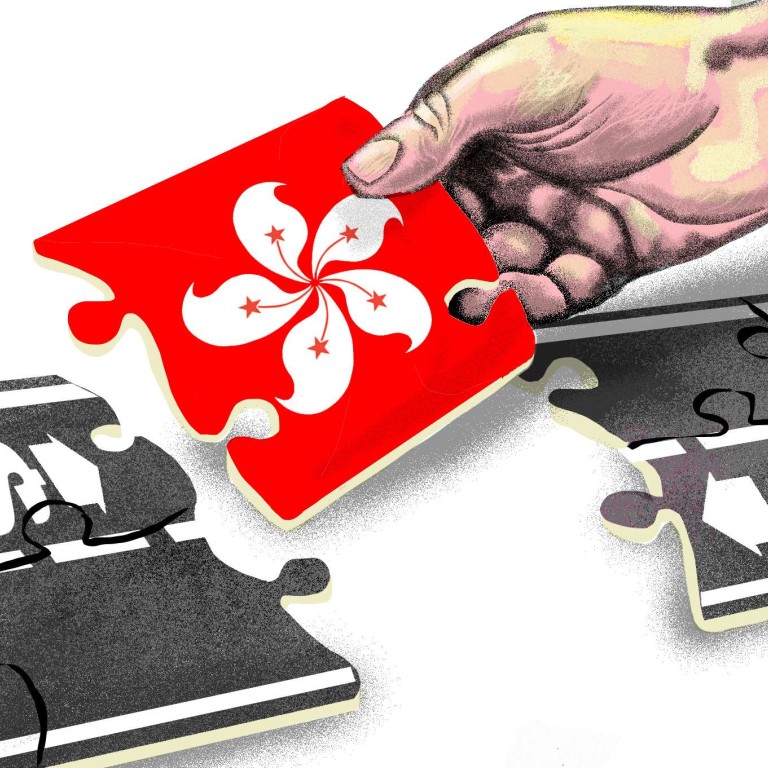
Hong Kong, the dealmaker for China’s ‘One Belt, One Road’
Peter Wong details how the city’s strengths can be tapped to seal the partnerships needed to move China’s key initiative forward

China’s ‘One Belt, One Road’ is the perfect stage for Hong Kong to showcase its strengths
In the past two years, China has made encouraging progress in implementing the initiative in various areas.
On the trade front, the total volume of bilateral trade between China and the countries officially involved in the initiative hit US$996 billion last year – around a quarter of China’s total trade volume. At the same time, Chinese companies have invested over US$14.8 billion in the countries along the routes, an increase of over 18 per cent year on year. Around US$8.5 billion worth of investment from those countries has flowed into China, up by more than 23 per cent.

AIIB and World Bank reach deal on joint projects
On the infrastructure front, major progress has been achieved in the Pan-Asia high-speed railway network. China has won the contract to build Indonesia’s first national bullet rail link – the 150km Jakarta-Bandung line. It is bidding on the high-speed railway project linking the Malaysian capital Kuala Lumpur with Singapore. Beijing is also in talks with more than 30 countries including Russia, Thailand, Turkey, Saudi Arabia and Iran about high-speed rail projects.
On the financing front, seed funding for infrastructure projects along the belt and road has mainly come from the Chinese government, with support from Chinese commercial banks. Additional capital is also available from the newly formed Asian Infrastructure Investment Bank (AIIB), the New Development Bank and the Silk Road Fund – with total registered capital of US$240 billion – which are already starting to become active investors along the routes.
While China has allocated significant capital and resources to the belt and road, success of the initiative also requires cooperation between Chinese enterprises and foreign counterparts in everything from small-scale trade and investment to the delivery of large-scale multi-jurisdictional game-changing infrastructure.

Huge potential gains of China’s ‘One Belt, One Road’ are worth the risks
In particular, there is still a huge funding gap along the belt and road. The Asian Development Bank has estimated that Asian demand for infrastructure amounts to around US$750 billion per year up to 2020, yet it and the World Bank together are able to supply only about US$30 billion.
As an integral part of China, Hong Kong is fully capable of becoming the premier multichannel financing hub, from arranging debt financing to private equity investment, as well as serving as a springboard for mainland enterprises to reach the global market.
As one of the premier corporate treasury centres in Asia, Hong Kong also has a unique competitive advantage to be the treasury centre for the AIIB and businesses. Compared with other major financial centres, the city has proximity to the headquarters of the AIIB and other project sites, a strong forex deposit base and trading, efficient money market and cross-border payment systems, and low corporate tax rates.
One Belt, One Road: Hong Kong’s position in the Pearl River Delta ‘gives it an edge’
The most prominent advantage is that Hong Kong is a premier offshore renminbi centre to facilitate renminbi-denominated transactions, including payments, fundraising and liquidity provision. This is especially important for serving belt and road projects and furthering the international usage of the renminbi alongside development of the initiative.
Hong Kong’s pool of offshore renminbi liquidity is the largest in the world. Renminbi deposits stood at 759.4 billion yuan (HK$899 billion) at the end of March. The total remittance of renminbi for cross-border trade settlement amounted to 370.7 billion yuan in March, compared with 279.8 billion yuan in February.

Why people in Hong Kong scoff at China’s grandiose Belt and Road plans
Hong Kong is well positioned as the major offshore renminbi debt (dim sum bond) centre for infrastructure investments, including both structured debts and infrastructure bonds, among 20 other fully functioning offshore renminbi clearing centres. Hong Kong’s dim sum bond market is by far the largest in the world. The outstanding amount of dim sum bonds stood at about 400 billion yuan at the end of 2015, while the figure for Singapore was 50 billion yuan at the end of the second quarter of 2015.
The continuous improvement of offshore renminbi infrastructure in Hong Kong will help attract global investors trading debt in Hong Kong.
The belt and road initiative is bound to drive more mainland enterprises to ‘go global’
The belt and road initiative is bound to drive more mainland enterprises to “go global” and increase their overseas investment, and mergers and acquisitions activities. Hong Kong has always played an important role in helping mainland companies raise funds for international investments, mergers and acquisitions; and developing professional services, such as shipping, trade, legal and consultancy services.
The city is now the world’s largest platform for initial public offerings. A total of US$33.5 billion was raised via IPOs in the city last year. More than half of the market capitalisation of the city’s stock exchange is accounted for by mainland companies.
Besides, Hong Kong has a strong reputation regionally in project management for infrastructure construction. It is equipped with a rich pool of top professionals in risk management, project insurance, and technical and legal advice – essential resources for managing and financing infrastructure-related projects.
China’s belt and road initiative aims to change the political and economic landscape of China and the world. Hong Kong is well placed to leverage its strengths to provide financing support, treasury services, and serve as a springboard for mainland enterprises to reach the global market. In return, grabbing this opportunity could potentially change the centre of gravity of Hong Kong’s economic growth in the coming years.
Peter Wong is deputy chairman and chief executive of the Hongkong and Shanghai Banking Corporation Limited

